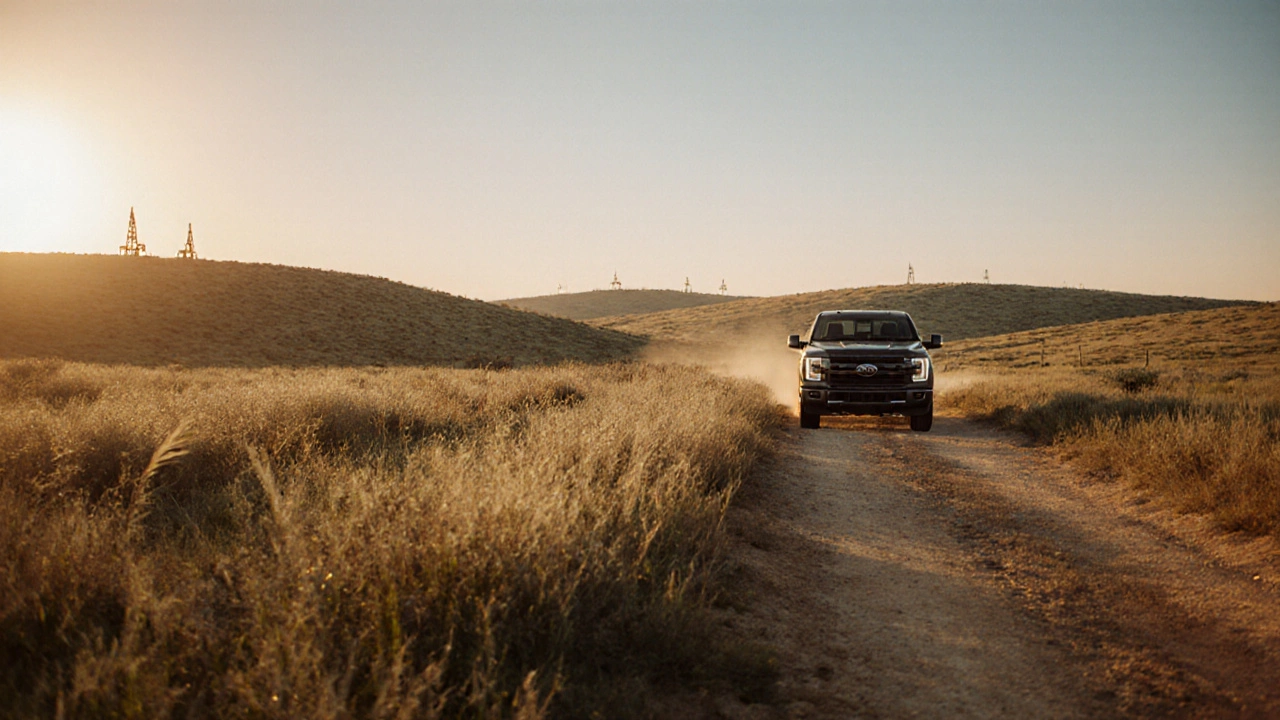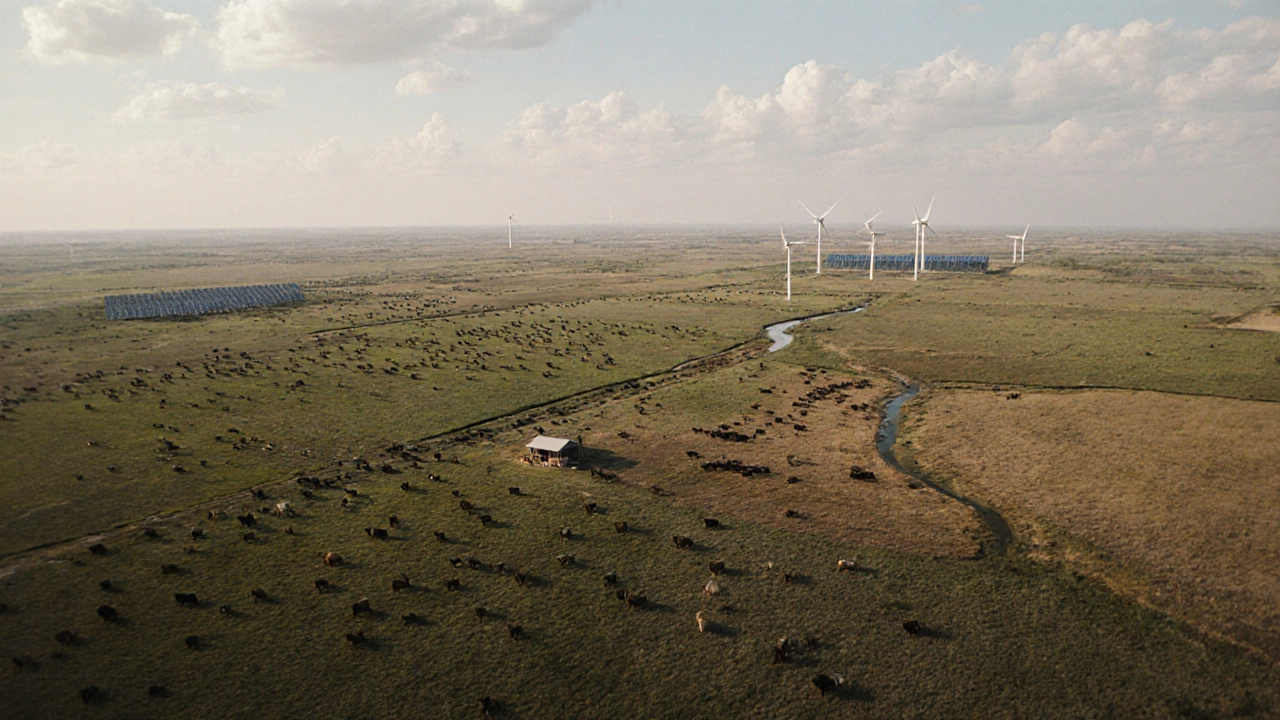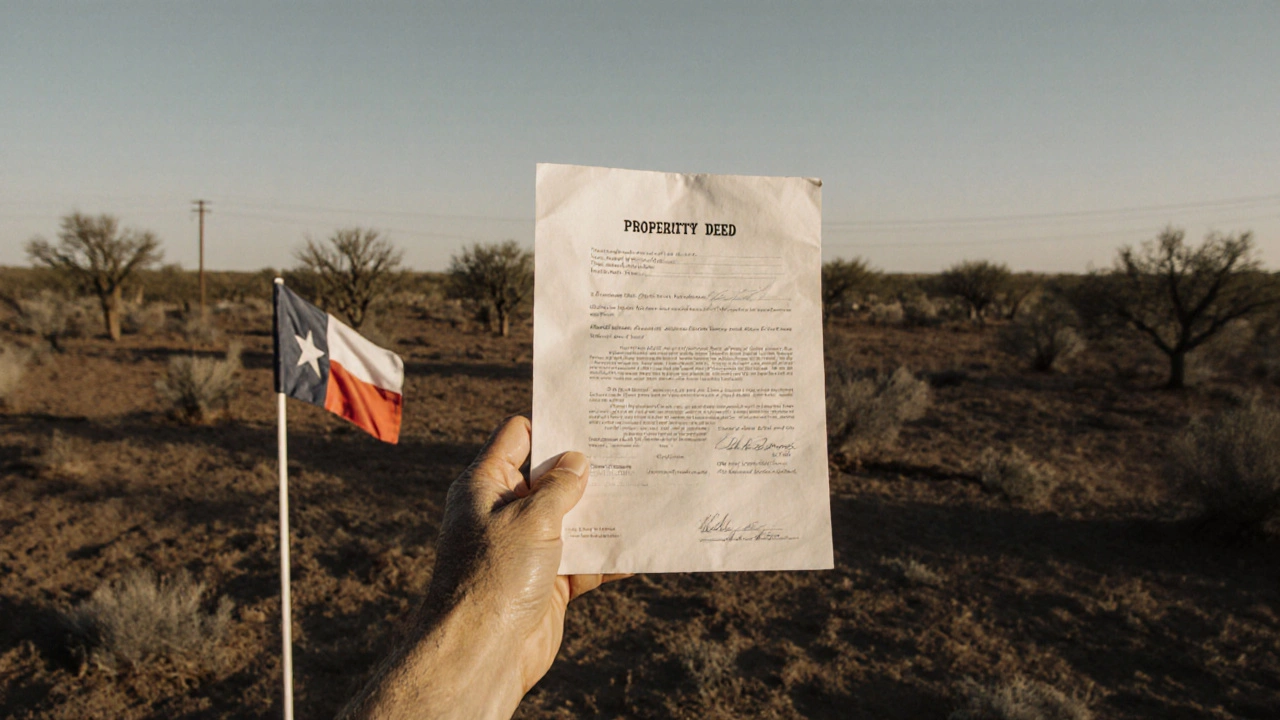Why Is Land in Texas So Cheap? The Real Reasons Behind Low Prices

Nov, 20 2025
Texas Land Value Calculator
Compare Land Value
See how much land you can buy in Texas versus California, Florida, and Oklahoma based on current prices.
Your Budget: $
Texas
Average price: $2,500/acre
$ acres
Includes: $ total ownership cost
(Based on typical infrastructure costs: water, power, road access)
California
Average price: $15,000/acre
$ acres
Includes: $ total ownership cost
(Based on typical infrastructure costs)
Land in Texas doesn’t just cost less than in California, New York, or even Florida-it often costs a fraction. You can buy 10 acres of rolling hill country outside Austin for the same price as a small lot in suburban Los Angeles. A 5-acre plot near San Antonio might set you back $40,000. In many parts of Texas, you can get a full square mile for under $200,000. That’s not a sale. That’s a system. So why is land in Texas so cheap? It’s not luck. It’s not magic. It’s a mix of laws, geography, history, and economic design.
Massive Land Supply
Texas is huge. Like, really huge. At 268,596 square miles, it’s the second-largest state in the U.S. after Alaska. But unlike Alaska, most of Texas is habitable. That means there’s an enormous amount of land available for sale. There are over 240 million acres of private land in Texas alone. That’s more than the entire land area of Germany. When supply is this high, prices naturally stay low. Compare that to California, where only about 10% of the land is privately owned, and much of it is protected, urbanized, or mountainous. In Texas, if you want land, you usually just have to find someone willing to sell it.
No State Income Tax
Texas doesn’t have a state income tax. That’s not just a perk for rich people-it reshapes the entire economy. Without income tax, the state relies on property taxes to fund schools, roads, and services. That means property taxes in Texas are among the highest in the country. But here’s the twist: because landowners pay taxes based on what the land is worth, the state has a strong incentive to keep land values low. If land prices soared, so would property tax bills. That would drive people out, reduce economic activity, and hurt local governments. So there’s a quiet, systemic pressure to keep land affordable. Sellers know this. Buyers know this. It’s part of the unwritten deal.
Strong Property Rights
Texas has some of the strongest private property rights in the U.S. Landowners have nearly total control over what they do with their land. You can build a cabin, raise cattle, drill for oil, or leave it wild-no permit needed in most rural areas. Zoning laws are minimal outside major cities. That freedom makes land more attractive to buyers who want flexibility. It also makes it less risky for investors. In states like New York or Massachusetts, you might need dozens of approvals just to put up a shed. In Texas, you can clear land, lay a foundation, and start building in weeks. That flexibility lowers the barrier to entry and increases demand from people who want to build something on their own terms.
Oil and Agriculture Dominate Land Use
Most of Texas’s land isn’t meant for housing. It’s meant for oil, gas, cattle, and cotton. In West Texas, you’ll find huge ranches that have been in families for generations. In the Panhandle, land is leased to energy companies for fracking. These uses don’t require high land prices-they require volume. A single oil well can generate millions in revenue from a few acres. A cattle ranch needs thousands of acres to be profitable. That means land is often valued based on its resource potential, not its resale value as a home lot. As a result, land prices stay low because they’re not being driven by housing demand. They’re being driven by what the ground can produce.

Population Density Is Low
Texas has over 30 million people, but they’re spread out. The state has 114 counties, and 20 of them have populations under 10,000. Many rural areas have fewer than 10 people per square mile. That’s not a problem-it’s a feature. Low population density means less competition for land. There’s no rush to buy. No bidding wars. No inflated prices. In places like East Texas or the Hill Country, you can walk into a real estate office and buy land with cash, no mortgage needed. You don’t need to compete with tech workers or out-of-state investors. The market moves slowly, and that keeps prices grounded.
Land Is Often Unimproved
When you buy land in Texas, you’re rarely buying a finished product. Most parcels have no water, no power, no septic system, no road access. That’s not a flaw-it’s the norm. In many cases, the land is raw. You’re paying for dirt, trees, and a survey. You’re not paying for infrastructure. Compare that to buying a lot in Florida or Colorado, where even remote parcels often come with utilities, paved roads, and HOA rules. In Texas, you get the land cheap because you’re expected to build everything yourself. That’s a trade-off. You save money upfront, but you pay later in time, labor, and cash. But for people who don’t mind doing the work, it’s a bargain.
Speculators Don’t Drive Prices
In California, land prices are often inflated by speculators buying up property hoping to flip it for a profit. In Texas, that happens too-but not nearly as much. Why? Because the return on investment is slower. It takes longer to get permits, longer to connect utilities, longer to find buyers. The market doesn’t move fast enough to make flipping land profitable for most. That means fewer people are trying to game the system. Fewer buyers chasing the same land = lower prices. You’re not competing with hedge funds or out-of-state developers. You’re competing with farmers, retirees, and DIY builders who know the value of patience.

Legal Framework Favors Buyers
Texas has a long history of legal protections for landowners. The state’s constitution explicitly protects private property from eminent domain abuse. Courts have consistently ruled in favor of landowners in disputes over access, mineral rights, and water usage. That legal stability makes Texas land a safer bet. Buyers don’t worry about sudden regulations, environmental restrictions, or lawsuits shutting them down. That confidence lowers risk-and risk lowers price. When you know you can build, drill, or farm without constant legal headaches, you’re willing to pay less upfront.
Land Is Seen as a Tool, Not a Status Symbol
In places like New York or Hawaii, land is often bought for prestige. A big backyard. A waterfront view. A gated community. In Texas, land is bought for function. You want to build a home? You want to raise goats? You want to store RVs? You want to hunt? You want to escape the city? Land is a means to an end, not a trophy. That practical mindset keeps demand steady but not frantic. People aren’t paying extra for a name on a deed. They’re paying for utility. And utility doesn’t come with a luxury markup.
What You’re Really Paying For
When you buy land in Texas, you’re not just buying dirt. You’re buying:
- Freedom-to build what you want, how you want
- Space-room to breathe, away from neighbors
- Control-no HOAs, no restrictive covenants
- Opportunity-oil, wind, solar, farming, or future development
It’s not cheap because it’s worthless. It’s cheap because the system is designed to make it accessible. The state doesn’t need to inflate prices to fund itself. The market doesn’t need to compete for scarce space. The culture doesn’t demand luxury. That’s why land in Texas stays affordable-and why it’s one of the last places in America where you can still buy a piece of the open country without selling your soul.
Is land in Texas really that cheap compared to other states?
Yes, by a wide margin. In 2025, the average price per acre for rural land in Texas is around $2,500. In California, it’s over $15,000. In Florida, it’s $8,000. Even in neighboring Oklahoma, prices are 40% higher than in comparable Texas regions. The difference isn’t just in location-it’s in policy, supply, and culture.
Can anyone buy land in Texas, even non-residents?
Absolutely. Texas has no restrictions on out-of-state or foreign buyers. You don’t need to be a U.S. citizen. You don’t need to live in Texas. You don’t even need to visit before buying. Many buyers purchase land sight-unseen based on satellite maps and surveys. Title companies handle the paperwork, and you can close remotely. That openness helps keep the market liquid and prices low.
Are there hidden costs when buying land in Texas?
Yes. The land might be cheap, but connecting water, electricity, and septic can cost $20,000-$50,000 depending on distance and terrain. Surveying, legal fees, and property taxes add up too. Property taxes average 1.8% of assessed value-higher than the national average. You also need to budget for road access, fencing, and maintenance. The upfront price is low, but the total cost of ownership can be high if you’re not prepared.
Is land in Texas a good investment?
It depends on your goals. If you’re looking for quick appreciation, probably not. Land in Texas rarely spikes in value overnight. But if you’re looking for long-term value, especially near growing cities like Austin, Dallas, or San Antonio, it can be excellent. Land near planned infrastructure-new highways, solar farms, or data centers-has seen 200-500% increases over 10 years. The key is timing and location, not just price.
What’s the best way to find cheap land in Texas?
Start with county tax assessor websites. They list properties with delinquent taxes-often sold at auction for far below market value. Look for land in remote counties like Terry, Garza, or Loving. Avoid the popular counties near Austin or Houston unless you’re willing to pay more. Work with a local land agent who knows the backroads and off-market deals. And always get a soil test, survey, and mineral rights report before buying.